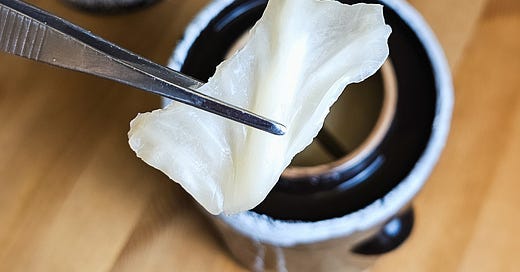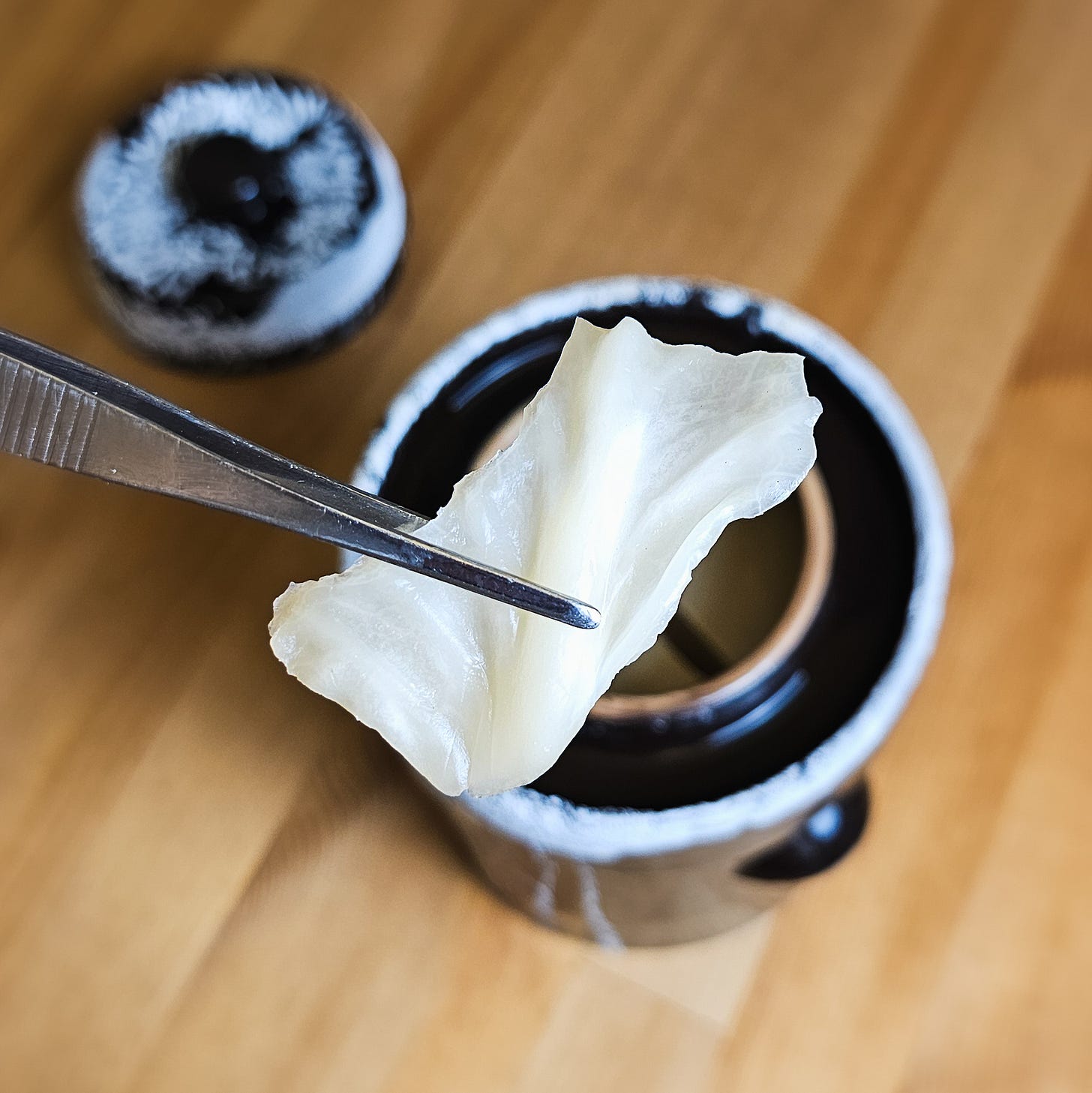Lactic and Acetic Acid Production in Sauerkraut Fermentation
Acetic acid production in sauerkraut fermentation is often overshadowed by the more dominant lactic acid, but it plays a crucial role in the final flavor profile and overall preservation
Lactic acid fermentation is a widespread method in Central and Eastern Europe, China, and Korea for preserving fresh vegetables. This preservation technique involves slicing or shredding raw vegetables and adding around 2 percent salt. The salt draws out moisture from the vegetables, creating an environment suitable for lactic acid bacteria to thrive.
During sauerkraut fermentation, the production of lactic acid and acetic acid plays a crucial role in the transformation of cabbage into its preserved form. Lactic acid is primarily produced through the metabolic activity of lactic acid bacteria (LAB), such as species belonging to the genus Lactobacillus and Leuconostoc. These bacteria ferment sugars present in the cabbage (mainly glucose and fructose) into lactic acid under anaerobic conditions. This process not only acidifies the environment but also contributes to the characteristic sour taste of sauerkraut.
The balance between these acids, along with other fermentation byproducts, defines the sensory characteristics and quality of the final product.
Discover how to make delicious sauerkraut with our step-by-step recipe featured below!
Lactic and Acetic acid production in Sauerkraut fermentation
Lactic acid is produced during fermentation primarily by lactic acid bacteria. It has a slightly milder sour taste compared to acetic acid.
When consumed, lactic acid stimulates saliva production in the mouth due to its sour taste. This increased saliva production helps to moisten the mouth and throat, providing a refreshing sensation.
Acetic acid’s strong sour taste also triggers neural responses that can enhance the perception of refreshment. It activates taste receptors that signal to the brain, promoting a sense of satisfaction and hydration.
During sauerkraut fermentation, acetic acid production occurs through a series of biological processes primarily driven by lactic acid bacteria (LAB) and acetic acid bacteria (AAB).
Acetic acid production in sauerkraut fermentation enhances its flavor by contributing tanginess and acidity. Sauerkraut with a well-developed acetic acid content tends to have a pronounced tanginess that complements the natural umami and sweetness of cabbage, resulting in a savory, slightly sour, and refreshing flavor. The interaction of acetic acid with other fermentation by-products such as lactic acid and esters creates a complex flavor profile that is distinctively characteristic of well-fermented sauerkraut. Esters are compounds formed through reactions between acids and alcohols during fermentation, and they contribute fruity and floral aromas, which can add depth and complexity to the flavor profile of sauerkraut.
Initial Fermentation by Lactic Acid Bacteria (LAB):
Sauerkraut fermentation begins with the growth of lactic acid bacteria, primarily species of Leuconostoc and Lactobacillus;
These bacteria ferment sugars present in cabbage (mainly glucose) into lactic acid through anaerobic respiration. This process is facilitated by enzymes produced by the bacteria;
This lowers the pH, thereby inhibiting development of undesirable microorganisms that might destroy crispness and cause spoilage.
Role of Lactic Acid Bacteria:
Leuconostoc species are typically more prevalent in the initial stages of fermentation. They are heterofermentative, meaning they produce lactic acid, ethanol, and carbon dioxide from sugars.
Lactobacillus species (such as Lactobacillus plantarum) are more dominant as fermentation progresses. They are homofermentative, producing primarily lactic acid.
Formation of Lactic Acid:
Glucose undergoes glycolysis within the bacterial cells, producing pyruvate.
Pyruvate is then reduced to lactic acid by the enzyme lactate dehydrogenase, which regenerates NAD+ from NADH. This process occurs under anaerobic conditions.
Transition to Acetic Acid Production:
As the lactic acid concentration increases in the sauerkraut brine, conditions become more favorable for acetic acid bacteria (Acetobacter species) to thrive.
Acetic acid bacteria are aerobic and typically require oxygen to metabolize ethanol, which can be produced by the lactic acid bacteria during fermentation.
Acetic Acid Production:
Acetic acid bacteria oxidize ethanol (produced by the lactic acid bacteria) into acetic acid through aerobic respiration.
This oxidation process involves the enzyme alcohol dehydrogenase, which converts ethanol to acetaldehyde, and then acetaldehyde is further oxidized to acetic acid by aldehyde dehydrogenase.
Fermentation conditions:
The rate of fermentation completion varies with temperature and salt concentration.
At 7.5°C, fermentation progresses very slowly: bacteria grow slowly, achieving 0.4% acidity in approximately 10 days and 0.8…0.9% acidity within a month. Lactobacilli struggle to thrive at this temperature, often prolonging fermentation completion to up to 6 months.
At 18°C, the acidity (measured as lactic acid) reaches 1.7 to 2.3% in about 20 days, with a ratio of acetic acid to lactic acid around 1:4 – way to go.
At 32°C, similar fermentation activity occurs in just 8 to 10 days, primarily driven by homofermentative bacteria like Lb. plantarum and P. cerevisiae, resulting in predominantly lactic acid production, bold flavors, and mushy product.
The Simplest Sauerkraut Recipe
Ingredients:
1 medium-sized cabbage (about 1-1.5 kg)
2% by the cabbage weight of sea salt
Instructions:
Remove the outer leaves of the cabbage and rinse it under cold water
Cut the cabbage into quarters and remove the core. Slice the cabbage thinly.
Place the sliced cabbage in a large bowl and sprinkle the salt over it. Massage the salt into the cabbage using clean hands for about 5-10 minutes. This helps to break down the cell walls and release moisture. Wait for 1-2 hours.
Pack the cabbage tightly into a clean glass jar or fermenting crock, pressing down firmly with your fist as you go. The cabbage should be submerged in its own liquid.
Cover the jar with a lid and place it in a cool, dark place (around 18-22°C) to ferment.
Check it every few days. Press down on the cabbage to keep it submerged under the liquid. Skim off any foam or scum that may form on the surface.
Ferment the sauerkraut for about 2-4 weeks, depending on your taste preferences.
In sauerkraut fermentation, the complex interplay of microorganisms underscores the fundamental truth that fermentation is always a community-driven process. No single bacterium works in isolation; rather, a dynamic consortium of lactic acid bacteria, yeasts, and sometimes acetic acid bacteria collaborate, each contributing to the flavor, texture, and preservation of the final product. This microbial community evolves throughout the fermentation process, with different species thriving at various stages, ensuring the transformation of simple cabbage into a nutrient-rich, flavorful sauerkraut. Understanding this symbiotic relationship not only highlights the importance of microbial diversity but also opens up possibilities for refining fermentation techniques to produce consistently high-quality sauerkraut.
connect with us on Instagram:
Denis Pashkov
cosmos society






